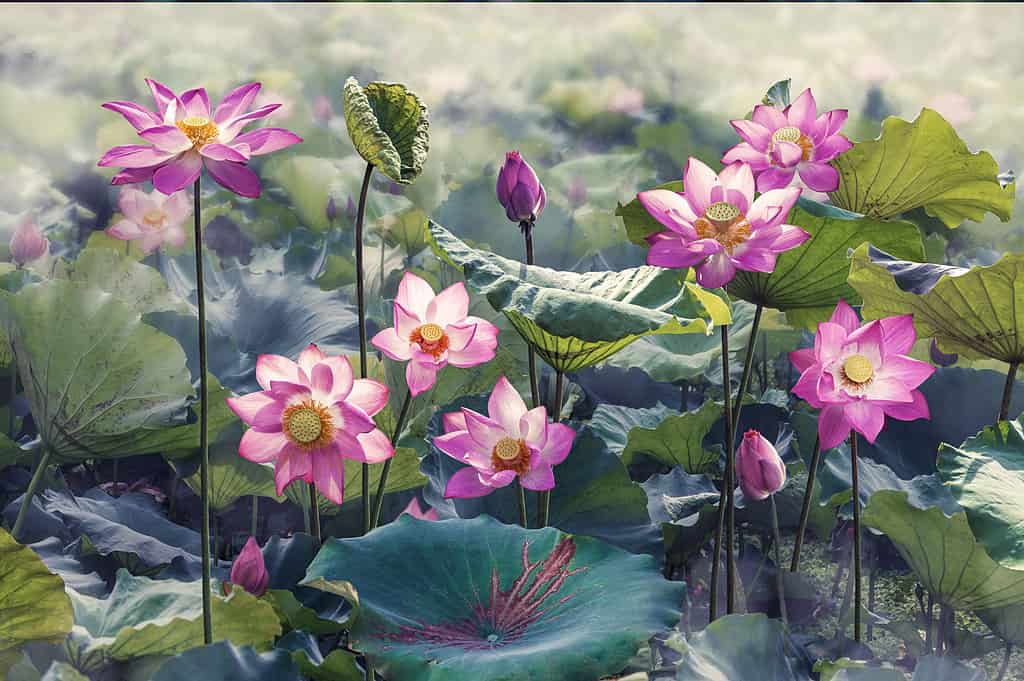India is a fascinating country filled with tons of diverse landscapes, unique culinary dishes, and outstanding historical landmarks. As the second largest English-speaking country in the world, India is one of the most popular travel destinations for many English speakers. Located in South Asia, the Republic of India is also recognized as the world’s largest democracy. They also have the world’s second-largest population, falling slightly behind China. Overall, this is a fascinating country, made even more interesting by its national flower.
You may not know this, but many countries worldwide choose a flower to represent them. India is one of these countries, and you may be surprised to find out what flower they chose and other fascinating facts about it and its overall symbolism.
The Geographic Context for India’s National Flower
India is a huge country. In fact, it is considered the seventh-largest country in the world by size alone. With that in mind, it would only make sense that the country’s landscape would be incredibly diverse — and it is! The Indian Ocean borders India’s coasts in the south. On the other hand, in the north, you’ll find enormous mountain ranges, such as the Himalayas, which are the highest peaks in the world.
Since the land is so vast and the geography so distinct, it would make sense that the overall climate would range as well. Many people immediately classify India with sweltering heat. While this is true, it’s only part of the story. India’s climate can range from freezing cold conditions in the Himalayas to excruciating heat in other parts of the country. Additionally, India also has a monsoon season that impacts them with heavy rain and downpours.
Overall, the climate is quite unique, so they chose to select a flower that is quite prevalent throughout the country to represent them. So, let’s find out what this flower is!

The skyline of Mumbai, India.
©iStock.com/Ajay Salvi
Lotus: The National Flower of India
Lotus is the national flower of India. This flower is an aquatic plant that is part of the Nelumbonaceae family. It is also sometimes called a “water lily.” One of the characteristics that make the lotus flower so unique is that its roots are grounded in the soil of ponds and rivers. However, the petals and leaves actually stay above water, gracing us with their beauty as they look forward to the sun.
This flower has a wide native distribution as well, primarily along East Asia. It is native to India and has always thrived in semi-tropical conditions. Outside of India, you’ll find this flower grows in Sri Lanka, northern Indochina, Bali, New Guinea, Malaysia, Indonesia, and even Australia. When it comes to its appearance, the flower is typically found in white and pink shades. However, it can also grow in shades like blue and red.
So why was the lotus chosen as the national flower of India? Well, it makes sense when you take into account the fact that it has a lot of symbolism associated with it in Indian culture. It has long held an important spot in a lot of the mythology and art of the country’s ancient beliefs. Now that we know more about this flower, let’s find out where it grows throughout India.

Lotus is an aquatic plant native to India and thrives in semi-tropical conditions.
©Le Manh Thang/Shutterstock.com
Where Does Lotus Grow in India?
As we mentioned above, the lotus flower does extremely well in semi-tropical conditions. As a result, they are native to India. The flower actually grows all throughout the country. Since it grows all throughout the country, it has a lot of genetic variances depending on where it is located. There are many different sizes and shapes in which they grow, including some flowers that can grow up to 160 petals. Two great places to see an abundance of lotus flowers is at the Bandhavgarh National Park and the Eravikulam National Park. Now that we know where it grows, let’s learn more about this beautiful flower’s symbolism and cultural significance.
What Is the Cultural Significance of Lotus?
The lotus flower is considered a sacred flower in India. Throughout the country’s history, this beautiful flower has been known to symbolize beauty, rebirth, divinity, fertility, knowledge, and wealth. It is also considered a symbol of triumph and enlightenment. One of the main reasons behind this symbolism is the simple fact of how the lotus grows. Its roots are planted into the mud and soil of freshwater sources. However, despite growing in muddy waters, it emerges out of the water as a beautiful flower that opens up its petals when the sun is out and closes them up at night. Thus, the symbolism of rebirth and strength makes complete sense.
The flower has also been associated with many Hindu deities. Some of these deities include Lakshmi, Brahma, and Vishnu. In certain depictions, you’ll find that Lakshmi and Vishnu are depicted standing on a pink lotus flower. Saraswati, however, is usually depicted on a white lotus flower. Outside of the religious impact of this flower’s symbolism, it is also simply beautiful to look at, and as such, it is used in a lot of art and architecture throughout the country. You’ll find the lotus flower mentioned in literature and even ancient sculptures.
What Is Lotus Used For?
Outside of its beauty and religious use, the lotus flower actually has a lot of uses. Throughout history, the plant has been used in medicinal ways and has even been consumed. Also, you may have noticed a lotus flower is used as a garnish in East Asian dishes. In India specifically, the flower has many medicinal uses and is used in herbal therapy. The country uses the flower in a lotus herbal tea that is said to help those with heart problems and is also said to purify the blood.
The root of the lotus is often utilized for stomach and many intestinal issues. Additionally, the root is also used to help treat skin discoloration, throat issues, and even smallpox. In Ayurvedic medicine, the entire flower is used to treat many conditions. Outside of these medicinal uses, the flower is simply used for decorative purposes. There has also been scientific research into the lotus flower’s beneficial use in controlling soil erosion in desert areas. It is also an important food source for many animals, and they also help cool down water temperatures as well. This nifty little flower is so much more than a beautiful plant to look at!
Other Native Plants and Flowers of India
Since the country has such a diverse landscape, the native flora that grows here is absolutely breathtaking. It has some of the richest native flora in the world. There are roughly 18,000 different species of flowering plants in the country. This means that six to seven percent of the world’s plant species are concentrated in the country. Let’s take a look at some of the most amazing plants in the country.
For starters, the banyan tree is a native tree in India that is a type of fig tree. What makes this tree so distinct is the fact that it has aerial roots that give it the appearance of a whole forest. It is actually the widest tree in the world! Another amazing plant found in India is jasmine. This flower is often called the “Belle of India” as it has a beautiful scent associated with it. It is classified as an evergreen shrub, and it has a wide variety of uses, such as being used as tea leaves, made into essential oils, and even perfumes.

Beautiful garden with blooming flowers in New Delhi. There are roughly 18,000 different species of flowering plants in the country!
©iStock.com/Wirestock
The photo featured at the top of this post is © T.Voekler / CC BY-SA 3.0 – License / Original
Thank you for reading! Have some feedback for us? Contact the AZ Animals editorial team.






